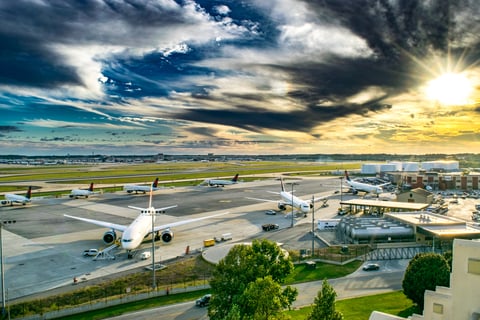
Stop, drop, and roll: most anyone who hears this phrase knows exactly what to do and why: they’re on fire!
As acts of fire prevention, we clean our chimneys, install smoke detectors (and change their batteries), and instruct children never to play with matches. But is fire safety really that simple?
Not exactly. And it becomes even more complicated when added risks—like proximity to flammable substances or large crowds—are part of the equation.
So how can we prevent fires? Enter: the National Fire Protection Association (NFPA). Let’s have a little Q&A.
What is the NFPA?
The NFPA is a non-profit organization that advocates for fire safety. Since its founding in 1896, the NFPA has worked to eliminate death, injury, and general loss caused by fire. Though the “N” in NFPA stands for “National,” the organization is widely respected and consulted on a global scale.
How do they work to prevent fire? Their mission is to offer free information, codes, and standards to the public in hopes of reducing risks and fire hazards. Through dedicated volunteers, technical committees, and tireless research, the NFPA has established more than 300 fire safety codes, creating a protocol for fire safety around the world.
Is adhering to NFPA guidelines mandatory?
Technically, no. The NFPA has no real authority since it is not a government-run association. They do not enforce or police their standards. However, NFPA recommendations are regularly adopted by state and federal agencies that do have the power to require standard observance, and following the NFPA recommendations just makes good sense. Why risk loss of life and property over a preventable incident?
What is NFPA 407?
NFPA 407 is the fire standard for aircraft fueling services. Handling a flammable substance always calls for added caution, but that’s especially true of aircraft fueling. There are numerous risks involved, including fire, explosions, flash point, and environmental contamination, any of which could lead to the loss of human life. Despite holding equipment, operations, and personnel to the highest standards, mishaps still happen. Being adequately prepared for the worst-case scenario is essential.
What steps does the NFPA recommend?
NFPA 407 is an exhaustive resource for fueling safety that offers guidelines for every step of the process. The standard outlines requirements for general fueling operations, aviation fueling facilities, airport fueling vehicles, and more. For those in the industry, owning a copy of this manual is strongly recommended.
Here are some highlights:
- Conduct regular fuel inspections of storage tanks, fueling equipment, and fueling vehicles. The Federal Aviation Administration (FAA) requires inspections every three calendar months.
- Report spills to the airport fire crew. Anything larger than ten feet in any direction or 50 feet in the area should be reported.
- Don’t smoke! Fueling vehicles should not be equipped with ashtrays or lighters, and lighters of any kind are forbidden in the vehicle’s vicinity.
- Park unused fueling vehicles at least 50 feet away from aircraft and buildings (with the exception of garages and maintenance buildings).
- Display appropriate “flammable” signage on fueling vehicles: one on the back and one on each side.
- At least two fire extinguishers should be present on all fueling vehicles, mounted on each side.
- Install manual controls (often referred to as a dead man’s switch) to prevent accidents, and ensure they are working properly.
- Employ interlocking fuel systems on fuel servicing vehicles—the vehicle shouldn’t be able to move unless all hoses are properly put away.
- Have a secondary emergency shut-down system to prevent spills from overfilled tanks.
What are some common fire-safety mistakes?
Complacency: staff gets comfortable with their surroundings and neglects to stay vigilant. Fire extinguishers, which should always be easily accessible, near an exit, and in the path to the emergency shutoff switch, are often misplaced and fail to meet these requirements.
Inaccurate Testing: inspectors often forget to properly test every aspect of a fueling truck. Common errors include forgetting to check the bonding cables—cables that connect to the truck’s frame—and the interlocking brakes.
Why comply with NFPA 407?
Perhaps a better question would be: why not? The NFPA doesn’t create regulations without reason. Each code is carefully created by a team of diligent experts, including engineers, electricians, and other members of the industry. They welcome public input to make each code an accurate representation of best practices for the people who spend their days fueling aircraft.
Following NFPA 407 is simply the responsible choice.
How can Dixon® help?
Dixon doesn’t mess around, especially when it comes to safety. A number of our API valves and overfill controls meet the high standards recommended by the NFPA, but we recommend two of our products in particular:
- Overfill Detection
An overfill detection system uses sensors to detect when a flammable liquid has reached a dangerous level. It serves as a safeguard against accidental spills and overfull tanks. Overfill systems are designed to safely handle flammable liquids and prevent them from spilling.
In the case of fuel, an overfill detection system is extremely helpful. Reduced spills mean less risk of fire or explosion, fewer incident reports, and more money saved—preventing a spill is so much easier and less expensive than cleaning up after one.
Dixon’s reliable FloTech™ products are interchangeable with all other brands and are also backed with world-class technical support.
2. Alarm Interface Module
An alarm interface module is used in trans-loading between mobile tanks or remote storage and a cargo tank. These modules provide visual and audible alarms and are suitable for any hazardous location, making them ideal for pump-off control and an excellent choice for fuel vehicles.
Interested in learning more about complying with NFPA 407, how Dixon can help prevent fires or our line of FloTech™ or ADS products? Explore dixonvalve.com, or talk to a specialist at 877.582.3569.
Sources:
- https://www.nfpa.org/
- https://www.icao.int/NACC/Documents/Meetings/2012/ICAOFAAAGACertification2012/ICAOFAACertification14.pdf
- https://docs.google.com/forms/d/e/1FAIpQLScGxhRKBXWAhsh4_CLgv8-Am2X3UMEcgZosjGNVhZd6ACD4hQ/viewform?c=0&w=1
- https://airportimprovement.com/article/best-practices-fuel-safety-inspection


